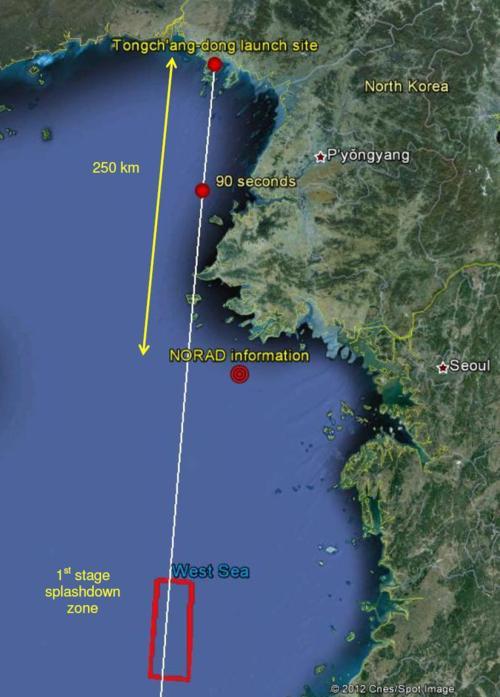
North Korea attempted its satellite launch at 7:39 am Friday Korean time (6:39 pm Thursday EDT), only to see the rocket fall into the water near the Korean peninsula less than two minutes into flight.
The U.S. released a statement after the launch that said:
North American Aerospace Defense Command and U.S. Northern Command officials acknowledged today that U.S. systems detected and tracked a launch of the North Korean Taepo Dong-2 missile at 6:39 p.m. EDT. The missile was tracked on a southerly launch over the Yellow Sea.
Initial indications are that the first stage of the missile fell into the sea 165 km west of Seoul, South Korea. The remaining stages were assessed to have failed and no debris fell on land. At no time were the missile or the resultant debris a threat.
The map above shows the launch site and the planned path of the rocket in white. The red dot labeled “NORAD information” shows the approximate location given in the U.S. announcement, which lies about 250 km along the planned trajectory. That location is well short of the splashdown zone Pyongyang announced for the first stage, which indicates that the failure took place while the first stage was burning.
The dot labeled “90 seconds” shows where the rocket would have fallen to earth if it had failed 90 seconds after launch. Since the first stage was intended to burn for about two minutes, this means that the failure occurred probably about 100 seconds after launch when the rocket was at an altitude of about 40 km and a range of 25 km from launch site. Its velocity at that point would be about 1.5 km/s.
Since the second stage would not have ignited at that time, this implies that the upper two stages and the satellite fell into the water along with the first stage.
From the NORAD information, it appears that the stage may have splashed down well east of the intended path. One possibility is that there was a guidance problem early on that caused the rocket to begin to veer from its path and that North Korea shut down the engines once that happened. Whether this was the scenario, or whether there was a catastrophic failure of some kind, may become clear as more information emerges.
Because the launch ended so early, North Korea would have gotten relatively little information from the launch that would be useful for advancing its development program.
Previous post on North Korea. Next post.
